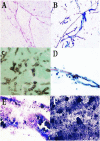The Accuracy of Histopathological and Cytopathological Techniques in the Identification of the Mycetoma Causative Agents
- PMID: 31465459
- PMCID: PMC6750607
- DOI: 10.1371/journal.pntd.0007056
The Accuracy of Histopathological and Cytopathological Techniques in the Identification of the Mycetoma Causative Agents
Abstract
Mycetoma is a devastating neglected tropical disease, caused by various fungal and bacterial pathogens. Correct diagnosis to the species level is mandatory for proper treatment. In endemic areas, various diagnostic tests and techniques are in use to achieve that, and that includes grain culture, surgical biopsy histopathological examination, fine needle aspiration cytological (FNAC) examination and in certain centres molecular diagnosis such as PCR. In this retrospective study, the sensitivity, specificity and diagnostic accuracy of grain culture, surgical biopsy histopathological examination and FNAC to identify the mycetoma causative organisms were determined. The histopathological examination appeared to have better sensitivity and specificity. The histological examination results were correct in 714 (97.5%) out of 750 patients infected with Madurella mycetomatis, in 133 (93.6%) out of 142 patients infected with Streptomyces somaliensis, in 53 (74.6%) out of 71 patients infected with Actinomadura madurae and in 12 (75%) out of 16 patients infected with Actinomadura pelletierii. FNAC results were correct in 604 (80.5%) out of 750 patients with Madurella mycetomatis eumycetoma, in 50 (37.5%) out of 133 Streptomyces somaliensis patients, 43 (60.5%) out of 71 Actinomadura madurae patients and 11 (68.7%) out of 16 Actinomadura pelletierii. The mean time required to obtain the FNAC result was one day, and for the histopathological examinations results it was 3.5 days, and for grain it was a mean of 16 days. In conclusion, histopathological examination and FNAC are more practical techniques for rapid species identification than grain culture in many endemic regions.
Conflict of interest statement
The authors have declared that no competing interests exist.
Figures





References
-
- van de Sande Wendy, Fahal Ahmed, Ahmed Sarah Abdalla, Serrano Julian Alberto, Bonifaz Alexandro, Zijlstra Ed, on behalf of the eumycetoma working group; Closing the mycetoma knowledge gap, Medical Mycology, 2018; 56(supp 1):153–164. - PubMed
MeSH terms
Supplementary concepts
LinkOut - more resources
Full Text Sources
Medical

